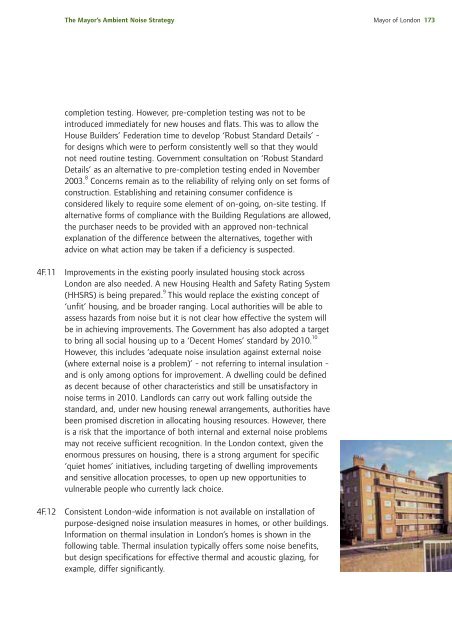The Mayor's Ambient Noise Strategy - Greater London Authority
The Mayor's Ambient Noise Strategy - Greater London Authority
The Mayor's Ambient Noise Strategy - Greater London Authority
Create successful ePaper yourself
Turn your PDF publications into a flip-book with our unique Google optimized e-Paper software.
<strong>The</strong> Mayor’s <strong>Ambient</strong> <strong>Noise</strong> <strong>Strategy</strong> Mayor of <strong>London</strong> 173<br />
completion testing. However, pre-completion testing was not to be<br />
introduced immediately for new houses and flats. This was to allow the<br />
House Builders’ Federation time to develop ‘Robust Standard Details’ -<br />
for designs which were to perform consistently well so that they would<br />
not need routine testing. Government consultation on ‘Robust Standard<br />
Details’ as an alternative to pre-completion testing ended in November<br />
2003. 8 Concerns remain as to the reliability of relying only on set forms of<br />
construction. Establishing and retaining consumer confidence is<br />
considered likely to require some element of on-going, on-site testing. If<br />
alternative forms of compliance with the Building Regulations are allowed,<br />
the purchaser needs to be provided with an approved non-technical<br />
explanation of the difference between the alternatives, together with<br />
advice on what action may be taken if a deficiency is suspected.<br />
4F.11 Improvements in the existing poorly insulated housing stock across<br />
<strong>London</strong> are also needed. A new Housing Health and Safety Rating System<br />
(HHSRS) is being prepared. 9 This would replace the existing concept of<br />
‘unfit’ housing, and be broader ranging. Local authorities will be able to<br />
assess hazards from noise but it is not clear how effective the system will<br />
be in achieving improvements. <strong>The</strong> Government has also adopted a target<br />
to bring all social housing up to a ‘Decent Homes’ standard by 2010. 10<br />
However, this includes ‘adequate noise insulation against external noise<br />
(where external noise is a problem)’ - not referring to internal insulation -<br />
and is only among options for improvement. A dwelling could be defined<br />
as decent because of other characteristics and still be unsatisfactory in<br />
noise terms in 2010. Landlords can carry out work falling outside the<br />
standard, and, under new housing renewal arrangements, authorities have<br />
been promised discretion in allocating housing resources. However, there<br />
is a risk that the importance of both internal and external noise problems<br />
may not receive sufficient recognition. In the <strong>London</strong> context, given the<br />
enormous pressures on housing, there is a strong argument for specific<br />
‘quiet homes’ initiatives, including targeting of dwelling improvements<br />
and sensitive allocation processes, to open up new opportunities to<br />
vulnerable people who currently lack choice.<br />
4F.12 Consistent <strong>London</strong>-wide information is not available on installation of<br />
purpose-designed noise insulation measures in homes, or other buildings.<br />
Information on thermal insulation in <strong>London</strong>’s homes is shown in the<br />
following table. <strong>The</strong>rmal insulation typically offers some noise benefits,<br />
but design specifications for effective thermal and acoustic glazing, for<br />
example, differ significantly.
















